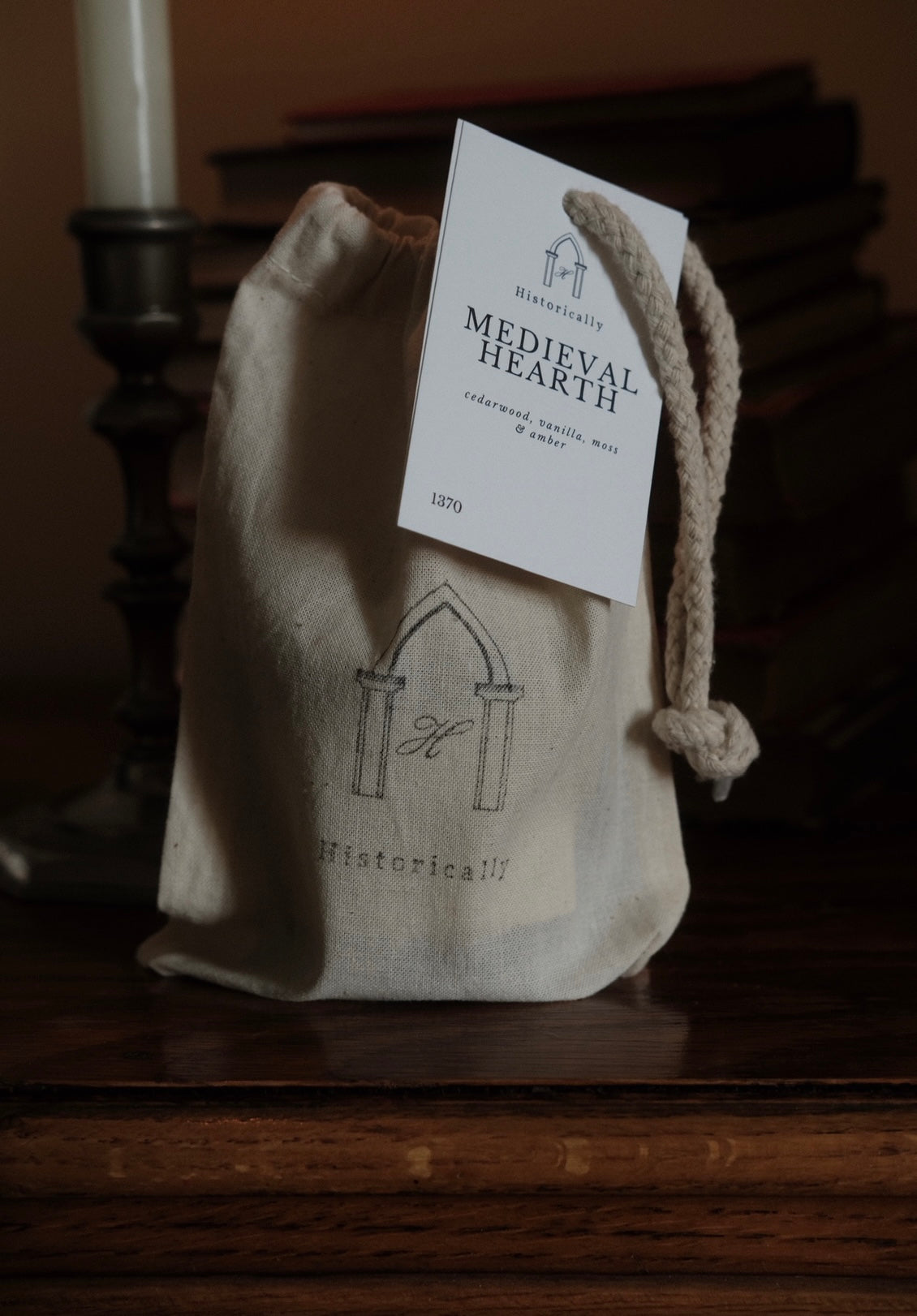Historically
Medieval Hearth
Medieval Hearth
Couldn't load pickup availability
Medieval Hearth.
Step into the storied halls of Haddon Hall, where shadows dance against carved stone and oak beams glow in the fire’s embrace. Cedarwood and moss weave through the air, deepened by warm vanilla and molten amber. This candle captures the spirit of a medieval gathering: the comfort of the hearth, the warmth of fellowship, and the timeless echo of history lingering in every flicker of flame.
Share
Scent Notes
Scent Notes
Cedarwood, smoke, vanilla, moss and amber
Delivery & Returns
Delivery & Returns
Dispatch times
Our candles are made to order and most will take between 1-7 business days to dispatch.
However, if you are wanting your order sooner or for a specific date please get in touch (via email or in the message box at checkout) and we can sort something out for you!
Delivery Times
We currently offer standard delivery with Royal Mail 2nd class which should arrive between 2-3 days after dispatch and Royal Mail 1st class which should arrive between 1-2 days after dispatch.
NOTE: Please note that during the months of November and December we use Royal Mail Tracked. This is more expensive than normal but we have found means that your parcels are safe and get to you in time.
Shipping outside the UK
We are more than happy to ship to America and Australia, unfortunately we cannot ship to the EU at this time.
If you would like an order to be delivered to Australia please do not hesitate to contact us via our contact page, email or Instagram message and we will calculate the shipping costs for you and complete your order via invoice.
Please note that customers are responsible for paying any import VAT, taxes and fees.
What is your return policy?
Please note earrings cannot be returned and refunded for hygiene reasons.
We are happy to accept returns if you are unhappy with your purchase.
Contact us within: 14 days of delivery
Dispatch items back within: 30 days of delivery
Request a cancellation within: 24 hours of purchase
Buyers are responsible for return postage costs. If the item is not returned in its original condition, the buyer is responsible for any loss in value.
Item damaged in transit
Sometimes accidents happen.
If you receive a parcel that has been damaged in the post please send a picture to us showing the damage within 48 hours of your parcel being delivered and we can discuss options with you. No worries.
Safety Information
Safety Information
Contains 6,7-Dihydro-1,1,2,3,3-pentamethyl-4(5H)-indanone. May cause an allergic skin reaction.
I. Keep candles away from curtains, fabrics, furniture, and draughts.
II. Avoid placing candles under shelves; maintain a 3-foot (1-meter) clearance above.
III. Prevent contact with clothes and hair; place candles out of reach.
IV. Keep children and pets at a distance from candles.
V. Maintain at least 4 inches (10cm) between burning candles.
VI. Extinguish before moving; avoid objects falling into hot wax.
VII. Never leave burning candles unattended.
VIII. Safely extinguish with a snuffer or spoon, not by blowing.
IX. Double-check to ensure candles are completely out.
Scent History
Scent History
Cedarwood:
Cedarwood boasts a rich history spanning millennia, utilized by ancient civilizations like the Sumerians and Egyptians for construction and even embalming due to its durability and natural resistance to decay. It held biblical significance in the construction of Jerusalem's Temples, symbolizing strength and longevity. Native American tribes, especially in the Pacific Northwest, valued cedar for crafting canoes, totem poles, and longhouses. Cedar chests gained popularity in the 20th century for their ability to repel insects. Today, cedar remains cherished for its aroma, durability, and resistance to decay, serving as a valuable resource in construction, furniture, and woodworking, while its historical importance endures worldwide.
Moss:
Moss has long held a quiet presence in the landscapes of the United Kingdom, thriving in its damp climate and shaded woodlands. In early Britain, it was valued for its practical uses — as insulation in dwellings, bedding, and even wound dressing due to its absorbent and antiseptic qualities. During the medieval period, moss was commonly employed to pack joints in timber buildings and line storage vessels. By the 18th and 19th centuries, as natural history became a national passion, mosses captivated collectors and botanists alike; figures such as Johann Dillenius and William Wilson helped establish bryology as a scientific discipline, recording and classifying Britain’s rich variety of moss species found in forests, moors, and stone walls across the isles.
Vanilla:
Vanilla, native to Mexico and Central America, reached Europe in the 16th century with Spanish explorers but remained rare for centuries, prized by the British elite for its exotic aroma and use in sweet drinks and desserts. Queen Elizabeth I was among its early admirers, helping it gain prestige. In the 19th century, Edmond Albius’s discovery of hand-pollination on Réunion revolutionised production, allowing cultivation in colonial regions such as Madagascar and Mauritius, which expanded British access. By the Victorian era, vanilla had become a hallmark of refinement, flavouring custards, puddings, and ice creams in homes across Britain.
Amber:
Amber, the fossilized resin of ancient trees, has a history spanning millions of years, dating back to the Eocene epoch. It was treasured in antiquity for its beauty and believed healing properties by the Greeks and Romans. During the Middle Ages, it was a luxury item, adorning objects like the famous Amber Room in Russia. In modern times, amber has unveiled ancient life forms, aiding our understanding of Earth's past. Today, it retains its value for its beauty, history, and scientific insights into ancient ecosystems.






